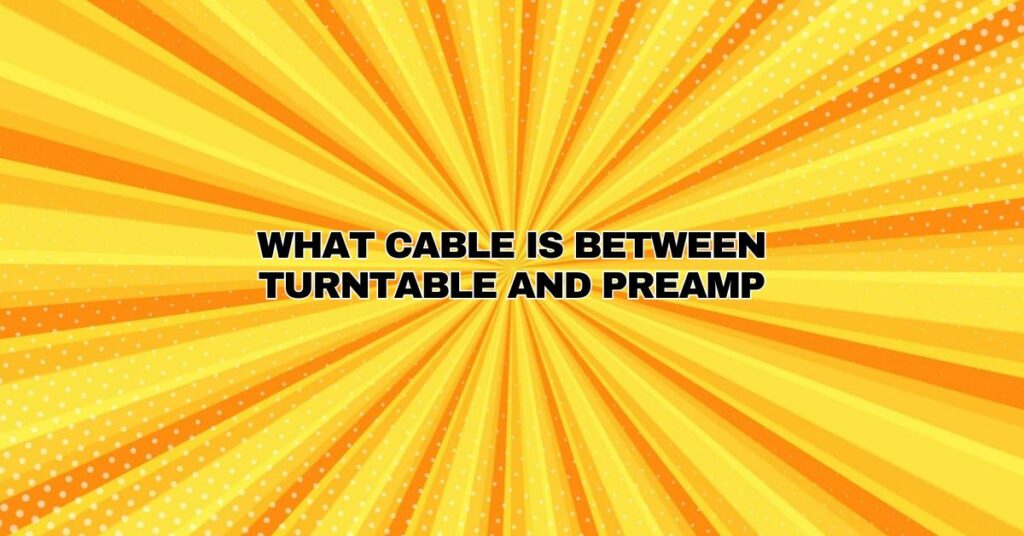When setting up a vinyl record playback system, selecting the right cable to connect your turntable to the preamp is a pivotal decision. The cable that bridges this gap plays a significant role in preserving the audio quality and ensuring an optimal listening experience. In this comprehensive article, we will explore the importance of the cable between your turntable and preamp, the types of cables available, and factors to consider when making your selection.
The Role of the Cable
The cable between your turntable and preamp serves as the conduit for the audio signal produced by the turntable’s cartridge. This signal, which is generated as the stylus tracks the grooves on the vinyl record, is extremely low-level and delicate. The primary functions of the cable include:
- Signal Transmission: The cable carries the analog audio signal from the turntable’s cartridge to the preamp. The integrity of this signal transmission is crucial to maintaining audio fidelity.
- Shielding: Cables are often shielded to protect the audio signal from external electromagnetic interference (EMI) and radio frequency interference (RFI). Proper shielding minimizes the risk of unwanted noise and distortion in the signal.
- Durability: A well-constructed cable is designed to withstand frequent use and movement, ensuring a reliable and consistent connection between the turntable and preamp.
Types of Cables for Turntable-to-Preamp Connection
Several types of cables can be used to connect your turntable to a preamp. The most common options include:
- RCA Cables: RCA (Radio Corporation of America) cables are widely used for audio connections in consumer and professional audio equipment. They feature distinctive red and white connectors for stereo audio signals and are commonly used to connect turntables to phono preamps or integrated amplifiers with built-in phono stages.
- XLR Cables: XLR (eXtra Low Resistance) cables are commonly associated with professional audio applications. They feature three-pin connectors (male and female) and are known for their balanced configuration, making them ideal for situations where noise rejection and audio quality are critical.
- DIN Cables: DIN (Deutsches Institut für Normung) cables use a circular connector with multiple pins. While less common in modern audio equipment, some vintage turntables and preamps may use DIN connectors for their connections.
- Coaxial Cables: Coaxial cables are typically used for digital audio connections but can also carry analog audio signals. They consist of a central conductor surrounded by insulation and a metallic shield. Coaxial cables may be used in some turntable setups.
- Balanced Cables: In high-end turntable setups, balanced cables, which can be XLR or TRS (Tip-Ring-Sleeve), may be used to maintain signal integrity over longer cable runs. However, these setups often require compatible balanced equipment.
Factors to Consider When Choosing the Cable
When selecting the cable between your turntable and preamp, consider the following factors:
- Cable Length: Measure the distance between your turntable and preamp to determine the required cable length. It’s advisable to keep cable lengths as short as possible to minimize signal degradation, especially for unbalanced cables like RCA.
- Cable Quality: High-quality cables with proper shielding and durable connectors are essential to maintain signal integrity and reduce the risk of interference. Consider investing in well-constructed cables from reputable manufacturers.
- Connector Types: Ensure that the connectors on the cable match the connections on your turntable and preamp. Most turntables use RCA connectors, while preamps may have RCA, XLR, or other types of inputs.
- Balanced vs. Unbalanced: If your turntable and preamp support balanced connections, consider using balanced cables for improved noise rejection, especially for longer cable runs.
- Budget: Cables come in a wide range of prices, from budget-friendly options to high-end audiophile cables. Balance your budget with your audio quality requirements to find the right cable for your setup.
- Cable Terminations: Check if the cable has the necessary terminations, such as straight or right-angle connectors, to fit your specific setup and cable routing.
Conclusion
In conclusion, the choice of cable between your turntable and preamp is a critical decision that can significantly impact the audio quality and overall performance of your vinyl playback system. Consider factors such as cable length, quality, connector types, and whether balanced or unbalanced cables are suitable for your setup. By choosing the right cable and ensuring a secure and reliable connection, you can enjoy the full richness and fidelity of vinyl records in your audio experience.


